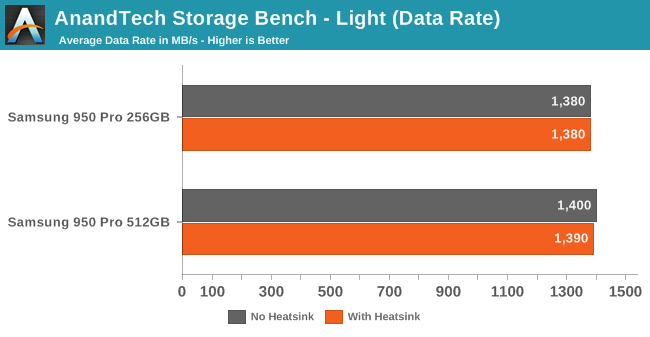The Angelbird Wings PX1 M.2 Adapter Review: Do M.2 SSDs Need Heatsinks?
by Billy Tallis on December 21, 2015 8:00 AM ESTAnandTech Storage Bench - Light
Our Light storage test has relatively more sequential accesses and lower queue depths than The Destroyer or the Heavy test, and it's by far the shortest test overall. It's based largely on applications that aren't highly dependent on storage performance, so this is a test more of application launch times and file load times. This test can be seen as the sum of all the little delays in a day's usage, but with idle times trimmed to 25ms it takes less than half an hour to run. Details of the Light test can be found here.

The read-oriented nature of the Light test allows the 950 Pro to show off its throughput capabilities, with an average data rate more than three times what any SATA drive has achieved. But with frequent idle times and not many writes, this test does nothing to make the 950 Pro overheat and the heatsink makes no difference.


The latency charts show virtually identical performance except for the number of 10ms+ outliers experienced by the 256GB drive. But on a test this short, that amounts to only about 16 more outliers and only 30ms difference in the total run time of the test. I'm actually surprised we're not seeing bigger random variation between runs.










69 Comments
View All Comments
edzieba - Tuesday, December 22, 2015 - link
With most Skylake ITX boards having the m.2 slot on the back, it would be interesting to see how well a simple coupling of the drive to the motherboard backplate with an adhesive thermal pad compares to the bare drive (and/or to a dedicated PCIe slot heatsink like this). I suspect the relatively tiny power levels involved (barely over 5W at most) would mean a nice sheet of aluminium or steel would be more than enough heatsinking for even sustained heavy loads.zodiacfml - Tuesday, December 22, 2015 - link
Performance of these drives are awesome that I would never be able to throttle them even if I try. Regarding the form factor, I believe they have designed it really well. It might be too big in 5 to years from now.fvbounty - Tuesday, December 22, 2015 - link
Can you post some temps, I'm surprised you didn't have them in the review?kilgor270 - Friday, January 1, 2016 - link
Just installed my PX1 with a Samsung SM951 as my boot drive. The PX1 seems to be very well constructed in my opinion. Easy to put the SM951 chip in and then install into computer.The white LED's were a surprise. Since I'm not a gamer, to me the leds are just an indication that power is going to the board. I monitored the heat using a couple software apps and at first glance without stressing it, it is hovering around 90 degrees F. Performance r/w is right around 1450 MBs +/-Overall for a couple days testing, I am very very happy with this combination as a boot drive. Totally changed my overall system profile in a very positive way.
orencom - Thursday, January 7, 2016 - link
the real question is weather there are real use cases which utilize PCIe SSD bandwidth capabilities...Machou360 - Sunday, January 10, 2016 - link
Just bought two of these and in RAID0, they are a beast ! Made the same bentches and putting a raspberry heatsink on each of the M2 controller simply avoids any heat issue (had to remote part of the sticker for that, which was very easy) I would recommend these drives anytime, performance is superb!XmppTextingBloodsport - Saturday, March 19, 2016 - link
"Will thrashing air about be efficacious?""Should we really rely upon [haphazard] fans for cooling?"
jefflynn333 - Sunday, September 4, 2016 - link
I would like to see the Angelbird tested against just using small heat sinks attached to the 950. That seems like a logical alternative.